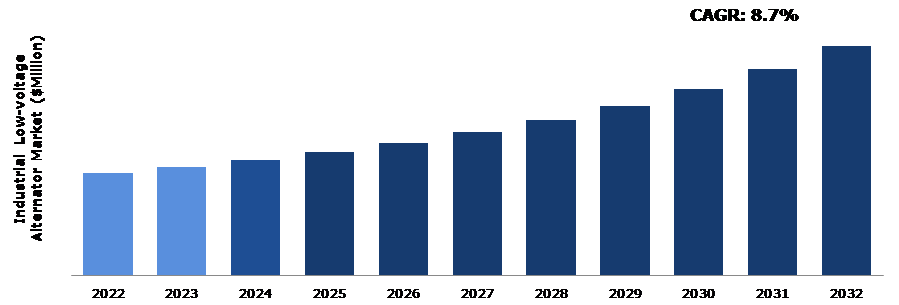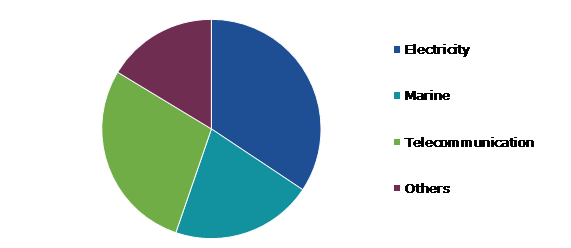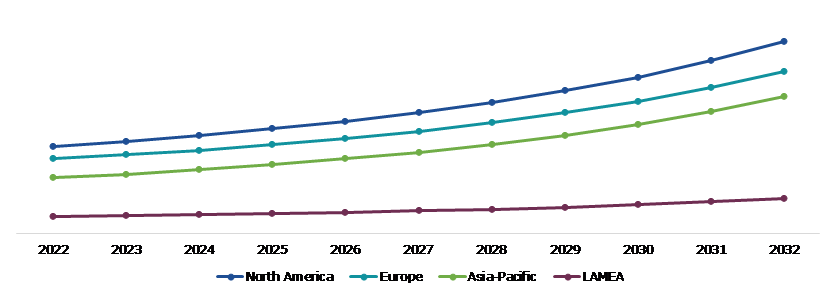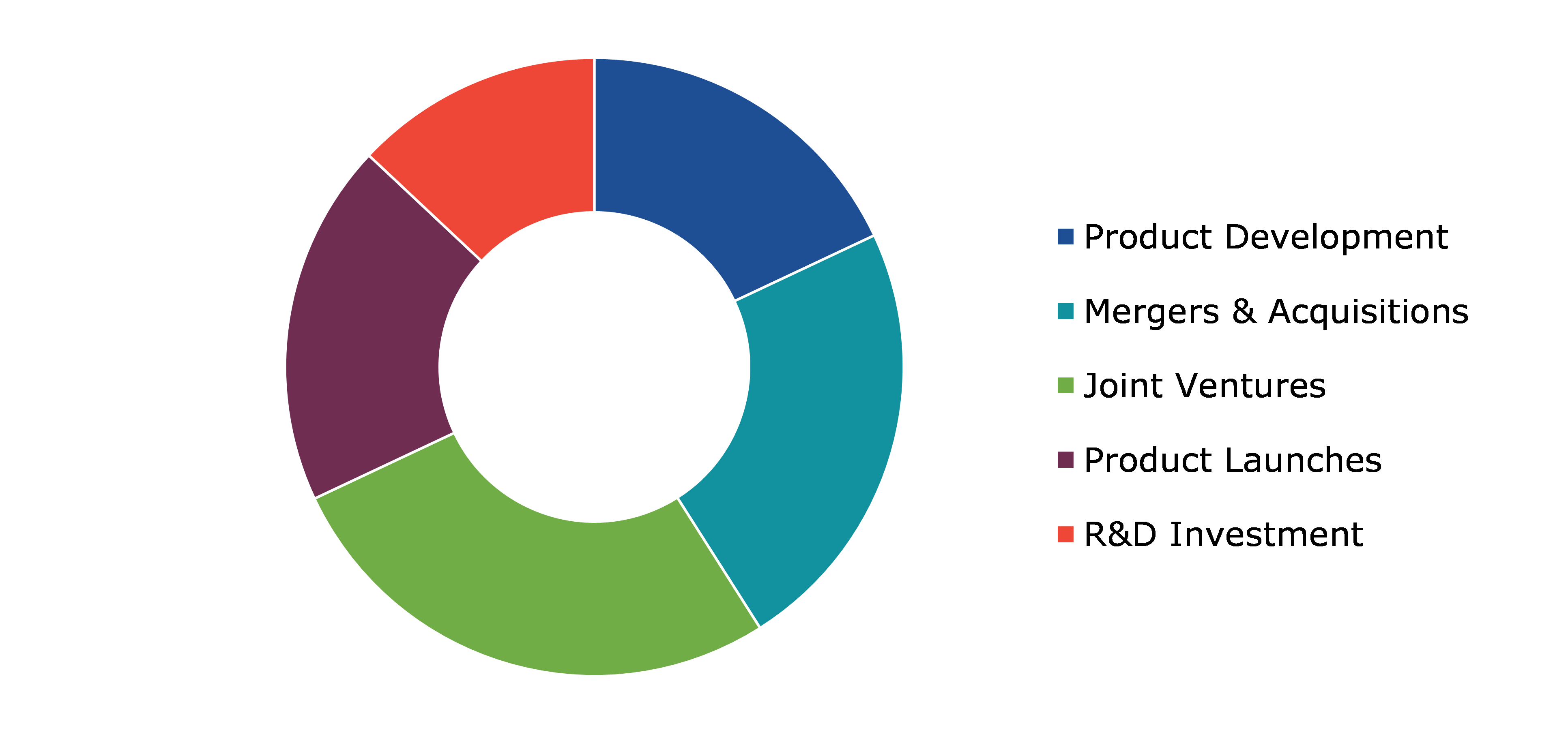Industrial Low-voltage Alternator Market Report
RA09201
Industrial Low-voltage Alternator Market by Type (Single Phase Industrial Low-voltage Alternator and Three Phase Industrial Low-voltage Alternator), Application (Electricity, Marine, Telecommunication, and Others), and Region (North America, Europe, Asia-Pacific, and LAMEA): Global Opportunity Analysis and Industry Forecast, 2023-2032
Industrial Low-voltage Alternator Overview
Industrial low-voltage alternators are integral components within various sectors, converting mechanical energy into electrical power efficiently. These alternators typically employ a rotating magnetic field coupled with a stationary armature, ensuring cost-effectiveness and simplicity in their design. This configuration allows for reliable generation of alternating current, catering to the specific voltage requirements of industrial applications. With a focus on powering machinery, equipment, and systems, industrial low voltage alternators play a crucial role in sustaining operations across manufacturing plants, construction sites, and other industrial settings.
Global Industrial Low-voltage Alternator Market Analysis
The global industrial low-voltage alternator market size was $1,505.50 million in 2022 and is predicted to grow with a CAGR of 8.7%, generating a revenue of $3,379.90 million by 2032.
Source: Research Dive Analysis
COVID-19 Impact on the Global Industrial Low-voltage Alternator Market
The COVID-19 pandemic significantly impacted the industrial low voltage alternator market, leading to a slowdown in growth. The economic downturn caused by widespread disruptions and reduced investments across various industries emerged as a primary factor hindering market expansion. Global supply chain disruptions disrupted the timely delivery of crucial components and raw materials essential for manufacturing industrial low voltage alternators. Moreover, import-export restrictions imposed by major producing countries, such as the U.S. and China, compounded these challenges. Industries heavily reliant on industrial low voltage alternators, such as construction & automotive sectors, experienced substantial declines in sales & project acquisitions due to pandemic-related uncertainties. For instance, within the construction industry, numerous projects faced delays or cancellations due to labor shortages, supply chain disruptions, travel restrictions, and concerns regarding the spread of COVID-19. These combined factors have resulted in a notable impact on the demand and growth trajectory of the industrial low voltage alternator market during the COVID-19 pandemic.
Increasing Demand for Reliable Power Supply Solutions in Industrial Settings Across the Globe Drive the Market Growth
Multiple factors are responsible for the growth and expansion of the industrial low-voltage alternator market. One of the key driving forces is rise in demand for dependable power supply solutions in industrial environments. Industries such as manufacturing, construction, and mining require consistent & reliable electricity to run machinery & equipment. Industrial low-voltage alternators provide a dependable supply of power, allowing for continuous operations and productivity. Furthermore, technological and design developments have resulted in the development of more efficient & durable alternators, driving up demand for industrial applications. Moreover, rise in the emphasis on energy efficiency and sustainability across industries has spurred the use of low-voltage alternators, which offer higher energy conversion rates and a lower environmental effect than traditional power production methods.
High Cost of Alternator to Restrain the Market Growth
The initial cost of industrial low voltage alternators is a significant obstacle to their broad use in specific applications. Alternators, in contrast to traditional generators, often have higher initial costs, presenting a difficulty for businesses working within limited budgets or cost-effective initiatives. While industrial low voltage alternators have long-term benefits such as increased efficiency & reliability, the initial expenditure dissuades some potential customers from selecting them over cheaper options at first. This barrier is especially significant in industries where capital expenditures are heavily inspected, such as small and medium-sized businesses (SMEs) or organizations with thin profit margins.
Advancements In Technology to Drive Excellent Opportunities
The industrial low-voltage alternator market is expanding rapidly, driven by technological improvements and changes in consumer demands for distributed energy solutions. Distributed energy is gaining pace due to improvements in speed, eco-friendliness, and customized options, driving demand for alternators in industrial applications. Power generation original equipment manufacturers (OEMs) are actively capitalizing on these prospects by focusing on improving electromechanical performance, increasing control, incorporating remote monitoring features, and broadening their applicability in renewable energy generation. These activities are consistent with the increasing emphasis on energy efficiency, sustainability, and operational flexibility in industrial settings. As enterprises seek dependable and efficient power generating solutions adapted to their individual needs, industrial low-voltage alternators are positioned to play a critical role in satisfying these demands.
Global Industrial Low-voltage Alternator Market Share, by Type, 2022
Source: Research Dive Analysis
The three-phase industrial low-voltage alternator segment accounted for the highest market share in 2022. Three-phase industrial low voltage alternators represent a cornerstone of modern industrial power generation, offering efficient and reliable electrical energy conversion for a wide range of applications. These alternators are designed to provide three-phase alternating current (AC) power at low voltages, catering to the diverse needs of industrial sectors such as manufacturing, construction, mining, and oil & gas. With their robust construction, advanced technology, and versatility, three-phase industrial low voltage alternators are indispensable components in industrial power systems, ensuring uninterrupted operations and optimal performance across various industrial settings.
Global Industrial Low-voltage Alternator Market Share, by Application, 2022
Source: Research Dive Analysis
The electricity segment accounted for the highest market share in 2022. Industrial low voltage alternators find versatile applications across various sectors, providing essential electricity solutions tailored to industrial needs. In manufacturing environments, these alternators power a multitude of machinery & equipment, ensuring continuous operation and optimal productivity. From conveyor belts to assembly lines, industrial low voltage alternators deliver the required electrical energy reliably, facilitating smooth production processes. In addition, in the construction sector, these alternators are utilized to supply power to construction sites, enabling the operation of power tools, lighting systems, and temporary structures. Their robust design and efficient energy conversion make them indispensable for powering critical activities in construction projects of all scales.
Global Industrial Low-voltage Alternator Market Size & Forecast, by Region, 2022 2032 ($Million)
Source: Research Dive Analysis
The North America industrial low-voltage alternator market size generated the highest revenue in 2022. Growth in various end-user industries, coupled with the escalating demand for electricity due to urbanization trends, is expected to drive market expansion in the region. Several factors contribute to this growth, including implementation of policies aimed at fostering the adoption of renewable energy sources such as solar & wind power across North American countries. Consequently, there is a heightened demand for industrial low voltage alternators, essential components for ensuring the protection and efficient functioning of electrical systems in these renewable energy applications. This increasing emphasis on renewable energy adoption aligns with broader sustainability initiatives and drives the need for robust power generation solutions, propelling the North America industrial low voltage alternator market opportunity.
Competitive Scenario in the Global Industrial Low-voltage Alternator Market
Product innovation & development and user experience are common strategies followed by major market players. For instance, in July 2021, Nidec Leroy-Somer announced the launch of the LSA 47.3 industrial alternator. The LSA 47.3 offered increased efficiency and starting kVA over its predecessor and benefited from the implementation of the latest technologies developed by Nidec Leroy-Somer.
Source: Research Dive Analysis
Some of the leading industrial low-voltage alternator market players are Cummins Inc., Mecc Alte SpA, Nidec Motor Corporation, Linz Electric S.p.A., ENGGA (Yangjiang) Electric Co., Ltd., ABB, DINGOL Pwoer Generation, FARADAY, Taiyo Electric Co., Ltd., and Soga S.p.A. Sogaenergyteam
| Aspect | Particulars |
| Historical Market Estimations | 2020-2021 |
| Base Year for Market Estimation | 2022 |
| Forecast Timeline for Market Projection | 2023-2032 |
| Geographical Scope | North America, Europe, Asia-Pacific, and LAMEA |
| Segmentation by Application |
|
| Segmentation by Type |
|
| Key Companies Profiled |
|
Q1. What is the size of the global industrial low-voltage alternator market?
A. The size of the global industrial low-voltage alternator market was $ 1,505.50 million in 2022 and is projected to reach $ 3,379.90 million by 2032.
Q2. Which are the major companies in the Industrial Low-voltage Alternator market?
A. Cummins Inc., Mecc Alte SpA, and Nidec Motor Corporation are some of the key players in the global industrial low-voltage alternator market.
Q3. Which region, among others, possesses greater investment opportunities in the future?
A. Asia-Pacific possesses great investment opportunities for investors in the future.
Q4. What will be the growth rate of the Asia-Pacific Industrial Low-voltage Alternator market?
A. The Asia-Pacific industrial low-voltage alternator market is anticipated to grow at 9.8% CAGR during the forecast period.
Q5. What are the strategies opted by the leading players in this market?
A. Product innovation and development of EV charging stations are two key strategies opted by the operating companies in this market.
Q6. Which companies are investing more in R&D practices?
A. FARADAY, Taiyo Electric Co., Ltd., and Soga S.p.A. Sogaenergyteam are the companies investing more in R&D activities for developing new products and technologies.
1. Research Methodology
1.1. Desk Research
1.2. Real time insights and validation
1.3. Forecast model
1.4. Assumptions and forecast parameters
1.5. Market size estimation
1.5.1. Top-down approach
1.5.2. Bottom-up approach
2. Report Scope
2.1. Market definition
2.2. Key objectives of the study
2.3. Market segmentation
3. Executive Summary
4. Market Overview
4.1. Introduction
4.2. Growth impact forces
4.2.1. Drivers
4.2.2. Restraints
4.2.3. Opportunities
4.3. Market value chain analysis
4.3.1. List of raw material suppliers
4.3.2. List of manufacturers
4.3.3. List of distributors
4.4. Innovation & sustainability matrices
4.4.1. Technology matrix
4.4.2. Regulatory matrix
4.5. Porter’s five forces analysis
4.5.1. Bargaining power of suppliers
4.5.2. Bargaining power of consumers
4.5.3. Threat of substitutes
4.5.4. Threat of new entrants
4.5.5. Competitive Rivalry Intensity
4.6. PESTLE analysis
4.6.1. Political
4.6.2. Economical
4.6.3. Social
4.6.4. Technological
4.6.5. Legal
4.6.6. Environmental
4.7. Impact of COVID-19 on Industrial Low-voltage Alternator market
4.7.1. Pre-covid market scenario
4.7.2. Post-covid market scenario
5. Industrial Low-voltage Alternator Market Analysis, By Type
5.1. Overview
5.2. Single Phase Industrial Low-voltage Alternator
5.2.1. Definition, key trends, growth factors, and opportunities
5.2.2. Market size analysis, by region, 2022-2032
5.2.3. Market share analysis, by country, 2022-2032
5.3. Three Phase Industrial Low-voltage Alternator
5.3.1. Definition, key trends, growth factors, and opportunities
5.3.2. Market size analysis, by region, 2022-2032
5.3.3. Market share analysis, by country, 2022-2032
5.4. Research Dive Exclusive Insights
5.4.1. Market attractiveness
5.4.2. Competition heatmap
6. Industrial Low-voltage Alternator Market Analysis, by Application
6.1. Overview
6.2. Electricity
6.2.1. Definition, key trends, growth factors, and opportunities
6.2.2. Market size analysis, by region, 2022-2032
6.2.3. Market share analysis, by country, 2022-2032
6.3. Marine
6.3.1. Definition, key trends, growth factors, and opportunities
6.3.2. Market size analysis, by region, 2022-2032
6.3.3. Market share analysis, by country, 2022-2032
6.4. Telecommunication
6.4.1. Definition, key trends, growth factors, and opportunities
6.4.2. Market size analysis, by region, 2022-2032
6.4.3. Market share analysis, by country, 2022-2032
6.5. Others
6.5.1. Definition, key trends, growth factors, and opportunities
6.5.2. Market size analysis, by region, 2022-2032
6.5.3. Market share analysis, by country, 2022-2032
6.6. Research Dive Exclusive Insights
6.6.1. Market attractiveness
6.6.2. Competition heatmap
7. Industrial Low-voltage Alternator Market, by Region
7.1. North America
7.1.1. U.S.
7.1.1.1. Market size analysis, by Type, 2022-2032
7.1.1.2. Market size analysis, by Application, 2022-2032
7.1.2. Canada
7.1.2.1. Market size analysis, by Type, 2022-2032
7.1.2.2. Market size analysis, by Application, 2022-2032
7.1.3. Mexico
7.1.3.1. Market size analysis, by Type, 2022-2032
7.1.3.2. Market size analysis, by Application, 2022-2032
7.1.4. Research Dive Exclusive Insights
7.1.4.1. Market attractiveness
7.1.4.2. Competition heatmap
7.2. Europe
7.2.1. Germany
7.2.1.1. Market size analysis, by Type, 2022-2032
7.2.1.2. Market size analysis, by Application, 2022-2032
7.2.2. UK
7.2.2.1. Market size analysis, by Type, 2022-2032
7.2.2.2. Market size analysis, by Application, 2022-2032
7.2.3. France
7.2.3.1. Market size analysis, by Type, 2022-2032
7.2.3.2. Market size analysis, by Application, 2022-2032
7.2.4. Spain
7.2.4.1. Market size analysis, by Type, 2022-2032
7.2.4.2. Market size analysis, by Application, 2022-2032
7.2.5. Italy
7.2.5.1. Market size analysis, by Type, 2022-2032
7.2.5.2. Market size analysis, by Application, 2022-2032
7.2.6. Rest of Europe
7.2.6.1. Market size analysis, by Type, 2022-2032
7.2.6.2. Market size analysis, by Application, 2022-2032
7.2.7. Research Dive Exclusive Insights
7.2.7.1. Market attractiveness
7.2.7.2. Competition heatmap
7.3. Asia-Pacific
7.3.1. China
7.3.1.1. Market size analysis, by Type, 2022-2032
7.3.1.2. Market size analysis, by Application, 2022-2032
7.3.2. Japan
7.3.2.1. Market size analysis, by Type, 2022-2032
7.3.2.2. Market size analysis, by Application, 2022-2032
7.3.3. India
7.3.3.1. Market size analysis, by Type, 2022-2032
7.3.3.2. Market size analysis, by Application, 2022-2032
7.3.4. South Korea
7.3.4.1. Market size analysis, by Type, 2022-2032
7.3.4.2. Market size analysis, by Application, 2022-2032
7.3.5. Australia
7.3.5.1. Market size analysis, by Type, 2022-2032
7.3.5.2. Market size analysis, by Application, 2022-2032
7.3.6. Rest of Asia-Pacific
7.3.6.1. Market size analysis, by Type, 2022-2032
7.3.6.2. Market size analysis, by Application, 2022-2032
7.3.7. Research Dive Exclusive Insights
7.3.7.1. Market attractiveness
7.3.7.2. Competition heatmap
7.4. LAMEA
7.4.1. Brazil
7.4.1.1. Market size analysis, by Type, 2022-2032
7.4.1.2. Market size analysis, by Application, 2022-2032
7.4.2. UAE
7.4.2.1. Market size analysis, by Type, 2022-2032
7.4.2.2. Market size analysis, by Application, 2022-2032
7.4.3. South Arabia
7.4.3.1. Market size analysis, by Type, 2022-2032
7.4.3.2. Market size analysis, by Application, 2022-2032
7.4.4. South Africa
7.4.4.1. Market size analysis, by Type, 2022-2032
7.4.4.2. Market size analysis, by Application, 2022-2032
7.4.5. Rest of LAMEA
7.4.5.1. Market size analysis, by Type, 2022-2032
7.4.5.2. Market size analysis, by Application, 2022-2032
7.4.6. Research Dive Exclusive Insights
7.4.6.1. Market attractiveness
7.4.6.2. Competition heatmap
8. Competitive Landscape
8.1. Top winning strategies, 2022
8.1.1. By strategy
8.1.2. By year
8.2. Strategic overview
8.3. Market share analysis, 2022
9. Company Profiles
9.1. Cummins Inc.
9.1.1. Overview
9.1.2. Business segments
9.1.3. Product portfolio
9.1.4. Financial performance
9.1.5. Recent developments
9.1.6. SWOT analysis
9.2. Mecc Alte SpA
9.2.1. Overview
9.2.2. Business segments
9.2.3. Product portfolio
9.2.4. Financial performance
9.2.5. Recent developments
9.2.6. SWOT analysis
9.3. Nidec Motor Corporation
9.3.1. Overview
9.3.2. Business segments
9.3.3. Product portfolio
9.3.4. Financial performance
9.3.5. Recent developments
9.3.6. SWOT analysis
9.4. Linz Electric S.p.A.
9.4.1. Overview
9.4.2. Business segments
9.4.3. Product portfolio
9.4.4. Financial performance
9.4.5. Recent developments
9.4.6. SWOT analysis
9.5. ENGGA (Yangjiang) Electric Co., Ltd.
9.5.1. Overview
9.5.2. Business segments
9.5.3. Product portfolio
9.5.4. Financial performance
9.5.5. Recent developments
9.5.6. SWOT analysis
9.6. ABB
9.6.1. Overview
9.6.2. Business segments
9.6.3. Product portfolio
9.6.4. Financial performance
9.6.5. Recent developments
9.6.6. SWOT analysis
9.7. DINGOL Pwoer Generation
9.7.1. Overview
9.7.2. Business segments
9.7.3. Product portfolio
9.7.4. Financial performance
9.7.5. Recent developments
9.7.6. SWOT analysis
9.8. FARADAY
9.8.1. Overview
9.8.2. Business segments
9.8.3. Product portfolio
9.8.4. Financial performance
9.8.5. Recent developments
9.8.6. SWOT analysis
9.9. Taiyo Electric Co., Ltd.
9.9.1. Overview
9.9.2. Business segments
9.9.3. Product portfolio
9.9.4. Financial performance
9.9.5. Recent developments
9.9.6. SWOT analysis
9.10. Soga S.p.A. Sogaenergyteam
9.10.1. Overview
9.10.2. Business segments
9.10.3. Product portfolio
9.10.4. Financial performance
9.10.5. Recent developments
9.10.6. SWOT analysis
Personalize this research
- Triangulate with your own data
- Request your format and definition
- Get a deeper dive on a specific application, geography, customer or competitor
- + 1-888-961-4454 Toll - Free
- support@researchdive.com






